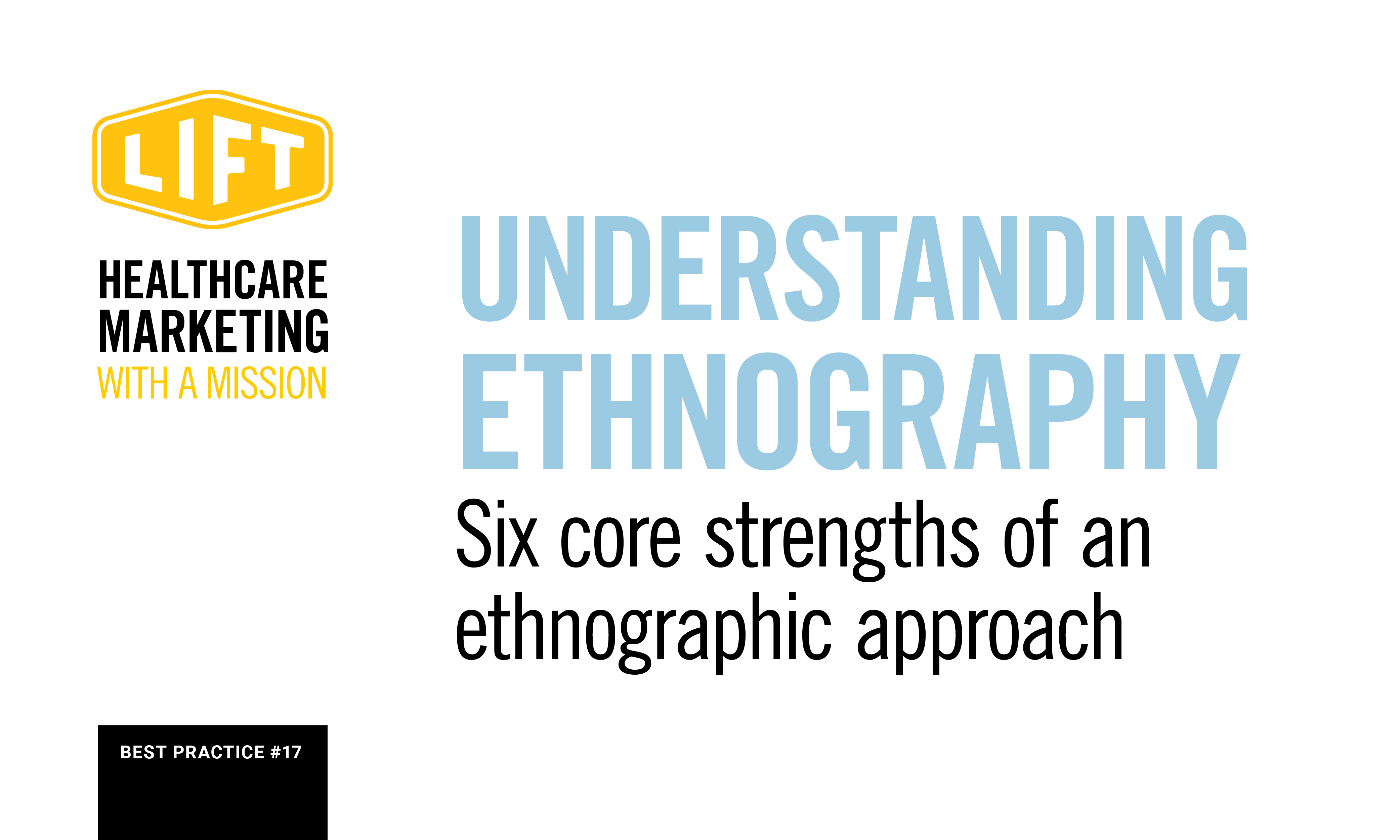Patient-Centricity & Retention: Qualitative Healthcare Insights Can Impact Both
Hospitals and pharmaceutical companies pay a premium for quantitative data. And in general, there’s an overabundance of such data available in the healthcare world. This is largely thanks to electronic health records, which make it all too easy to aggregate masses of patient info. There’s nothing inherently wrong with quantitative data. In fact, it’s incredibly useful and necessary for many applications. Quantitative data allows you to see the percentage of people who were discharged from hip surgery in your hospital, prefer faith-based care, think their access to women’s healthcare is adequate, etc.
What quantitative insights alone definitively cannot tell you is why.
Why are certain people recovering from hip surgery being re-admitted so frequently, why do people prefer faith-based care (or not), and why do some women see their healthcare access as inadequate? Patients are more than data points. And their ‘why’ matters.
This is where qualitative data comes in. Qualitative insights are uniquely positioned to capture the opinions and voices of your customers, the patients. Ultimately, real success lies in using and layering both quantitative and qualitative research—together.
Qualitative Insights Nurture Patient-Centric Healthcare (and Healthcare Marketing)
Patient-centricity has been on the rise in recent years. Finally, healthcare stakeholders are beginning to see the importance of centering the patient perspective.
This adoption of patient-centricity demands qualitative data. Why? Because qualitative data:
- Informs a patient-centric reading of quantitative data. If you look at your quantitative data in conjunction with your qualitative data, you can create programs and processes that accurately speak to patient needs. Quantitative data without a qualitative lens doesn’t tell patients’ full stories.
- Leaves space for nuance. Humans are incredibly complex creatures, yet quantitative data thrives in tidy spreadsheet rows. In reality, our experiences, especially our illness journeys, are anything but tidy — or even rational. Quantitative data may tell you X, but qualitative data leaves room for the patient to elaborate in not so black and white terms.
- Allows for depth and more meaningful understanding of the patient experience. In a similar vein, good qualitative research yields detailed narratives. Quantitative data provides breadth, and qualitative data — if you let it — balances that breadth with depth.
- Sheds light on new hypotheses. Quantitative data tests a hypothesis you already have. Qualitative data, on the other hand, has the power to form new hypotheses. With qualitative data, you’re empowered to address patient challenges you didn’t even know existed.
Why Healthcare Stakeholders Traditionally Overlook Qualitative Research
If qualitative insights are truly as powerful as we’ve made it out to be, why is it so often overlooked in the healthcare industry?
For one, it’s expensive. Quantitative data, as mentioned, is readily available in neatly packaged bundles. It’s much easier to gather high-level data points from existing digital records than it is to gather granular data more manually. Often, that leads to higher costs for qualitative data.
It also takes longer to attain qualitative data for these same reasons. Oftentimes, hospitals would rather have instant access to pages and pages of numbers than wait months for paragraphs of insights.
What’s more, so-called “big data” is sometimes overvalued in healthcare. It’s common for industry stakeholders to view big data as the answer to all things. And unfortunately, big data is synonymous with quantitative research.
Traditional Healthcare Marketing Focus Groups Give Qualitative Methods a Bad Rap
The final reason qualitative data takes a backseat to quantitative data is because it’s misunderstood.
Qualitative data gets a bad rap because it’s viewed as nothing more than a bunch of focus groups. Focus groups, when done well, can facilitate dynamic discussion between participants, but they oftentimes only scratch the surface on any given topic. Also, focus groups are (rightfully) seen as artificial and cold, yielding inorganic information from (knowingly or unknowingly) coerced participants.
Why would healthcare companies want to drop upwards of $20,000 on likely biased focus group results that likely won’t positively impact their healthcare marketing?
Ethnography is the “Real-Deal” Approach to Qualitative Research
It’s not incorrect to say that qualitative research is more expensive and more time consuming than its quantitative counterpart. That characterization of focus groups isn’t far off either.
But when done right, qualitative research is well worth the additional investment of time and money. Moreover, it shouldn’t look anything like a focus group.
Ethnography is a form of qualitative research that’s focused on observing and interacting with people in their day-to-day lived environments. Unlike focus groups, it doesn’t remove participants from their typical, comfortable spaces. Instead, it asks the researcher to put him or herself in the shoes of the community members.
This is a total departure from the detached nature of quantitative—and even some qualitative—research methods. Using ethnographic approaches, researchers are encouraged to form genuine connections and relationships with the people they’re studying. That connection begets intimacy, which yields more detailed and honest answers from participants. Of course, this results in more accurate and actionable data for you.
How Qualitative Data Benefits Hospitals and Pharmaceutical Companies
If most healthcare companies are devoted to quantitative data, why should you depart from the norm?
Again, you can’t get the kind of candid and detailed answers ethnography gives you from quantitative data. Think of all that you could do with truly unbiased information.
Further, if you care about communicating in a voice that resonates with the community you serve, it’s evident that you need qualitative data. After all, qualitative data gives you the patients’ actual words, and lots of them.
How Qualitative Insights Can Help Pharma Companies Retain Patients
For pharmaceutical companies, engaging with patients in a way they can relate to could mean safeguarding customers. What would you give to understand why someone stops taking your medicines, for instance? Since qualitative data gives you a window into the patient experience, including their experiences with your products, you just might get that answer. Then, you can address the barrier to the medicine to retain more customers.
How Qualitative Insights Can Help Hospitals Win Over Communities
Hospitals and healthcare networks will always need patients to keep their doors open. Since qualitative data offers you the nuanced insight necessary to engage with your community appropriately, you could attract more patients.
Qualitative data goes well beyond filling beds, too. Talking to your community in ways they understand and with mutual respect means you can educate everyone about healthcare—and they’ll actually listen. Qualitative research gifts you the building blocks to enable your prospective patients to be more accountable for their own healthcare. Empowered patients lead to better financial, clinical, and overall economic outcomes for your hospital and your community.
Putting It All Together: Quantitative and Qualitative Research
You should be investing in quantitative data. But unless you invest the same amount of resources in qualitative insights, you’re missing the mark. Blending both research methods will add a voice—your patient’s voice—to otherwise dull numbers. And patient-centric care hinges on understanding and responding to that voice with humanistic strategies and practices.

Six Reasons Why Ethnography is Superior for Qualitative Healthcare Research
At LIFT, we believe that the best way to capture meaningful and truly human-centered qualitative insights is through the practice of ethnography. Ethnography provides us with the capabilities necessary to dive deeply into patient and related stakeholder realities to better understand the complexity, breadth, and range of the patient and caregiver experience. To help you to better understand where ethnography might best fit in your marketing and market research strategy, we have assembled this free primer specifically that highlights six areas where ethnography brings unique value to healthcare marketers like you.
